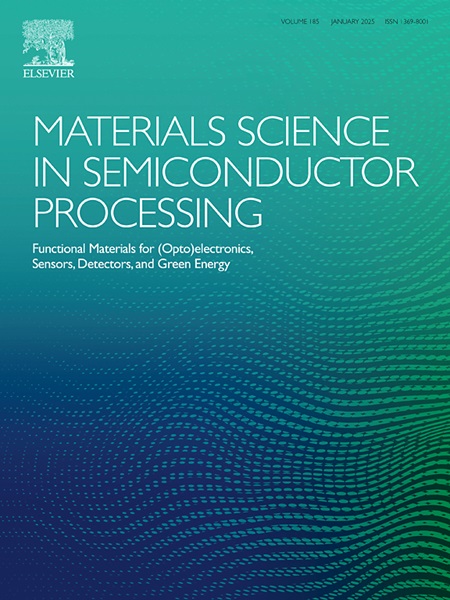High temperature resistance and wide-spectrum detection flexible photodetectors based on PbS quantum dots/Bi2S3 nanorods
IF 4.6
3区 工程技术
Q2 ENGINEERING, ELECTRICAL & ELECTRONIC
引用次数: 0
Abstract
High temperature resistance and broadband detection are crucial in the application of flexible photodetectors, and it is still challenging to achieve high quality performance using low-cost and simple fabrication methods. To widen the spectral response range and improve the photoperformance, a photoconductive PbS quantum dots (QDs)/Bi2S3 flexible photodetector was fabricated through physical vapor deposition and drop-coating processes on a flexible polyimide. This design is due to the excellent photoresponse of Bi2S3 in the ultraviolet and visible regions, and the remarkable tunability and respond of PbS QDs in the infrared band. The device has a broadband photoresponse under 365–1550 nm. The device has the maximum responsivity (R) of 3.59 mA/W and detectivity (D∗) of 4.34 × 1010 Jones under 638 nm illumination with a light intensity of 0.6 mW/cm2. And the response/recovery times are 0.35 s/0.45 s. The device exhibits excellent photoperformance even after multiple bends. When bent by 55 %, the photocurrent remains over 94 % of the initial value. Compared to Bi2S3 devices, PbS QDs/Bi2S3 flexible photodetectors have a 220-fold increase in on/off ratio. Moreover, the device can operate normally at 180 °C, demonstrating excellent temperature resistance characteristics. This work offers a new approach for designing high-performance flexible electronic devices with high temperature resistance and broadband response.
基于PbS量子点/Bi2S3纳米棒的耐高温广谱探测柔性光电探测器
耐高温和宽带检测在柔性光电探测器的应用中是至关重要的,使用低成本和简单的制造方法实现高质量的性能仍然是一个挑战。为了扩大光谱响应范围,提高光电性能,在柔性聚酰亚胺上采用物理气相沉积和滴涂工艺制备了光导PbS量子点/Bi2S3柔性光电探测器。该设计是由于Bi2S3在紫外和可见光区域具有优异的光响应,而PbS量子点在红外波段具有显著的可调性和响应性。该器件在365 - 1550nm范围内具有宽带光响应。该器件在638 nm光照强度为0.6 mW/cm2下的最大响应度(R)为3.59 mA/W,探测率(D *)为4.34 × 1010 Jones。响应/恢复时间为0.35 s/0.45 s。该器件在多次弯曲后仍具有良好的光性能。当弯曲55%时,光电流保持在初始值的94%以上。与Bi2S3器件相比,PbS量子点/Bi2S3柔性光电探测器的开/关比提高了220倍。此外,该器件可在180℃下正常工作,具有优异的耐温特性。这项工作为设计具有耐高温和宽带响应的高性能柔性电子器件提供了新的途径。
本文章由计算机程序翻译,如有差异,请以英文原文为准。
求助全文
约1分钟内获得全文
求助全文
来源期刊

Materials Science in Semiconductor Processing
工程技术-材料科学:综合
CiteScore
8.00
自引率
4.90%
发文量
780
审稿时长
42 days
期刊介绍:
Materials Science in Semiconductor Processing provides a unique forum for the discussion of novel processing, applications and theoretical studies of functional materials and devices for (opto)electronics, sensors, detectors, biotechnology and green energy.
Each issue will aim to provide a snapshot of current insights, new achievements, breakthroughs and future trends in such diverse fields as microelectronics, energy conversion and storage, communications, biotechnology, (photo)catalysis, nano- and thin-film technology, hybrid and composite materials, chemical processing, vapor-phase deposition, device fabrication, and modelling, which are the backbone of advanced semiconductor processing and applications.
Coverage will include: advanced lithography for submicron devices; etching and related topics; ion implantation; damage evolution and related issues; plasma and thermal CVD; rapid thermal processing; advanced metallization and interconnect schemes; thin dielectric layers, oxidation; sol-gel processing; chemical bath and (electro)chemical deposition; compound semiconductor processing; new non-oxide materials and their applications; (macro)molecular and hybrid materials; molecular dynamics, ab-initio methods, Monte Carlo, etc.; new materials and processes for discrete and integrated circuits; magnetic materials and spintronics; heterostructures and quantum devices; engineering of the electrical and optical properties of semiconductors; crystal growth mechanisms; reliability, defect density, intrinsic impurities and defects.
 求助内容:
求助内容: 应助结果提醒方式:
应助结果提醒方式:


